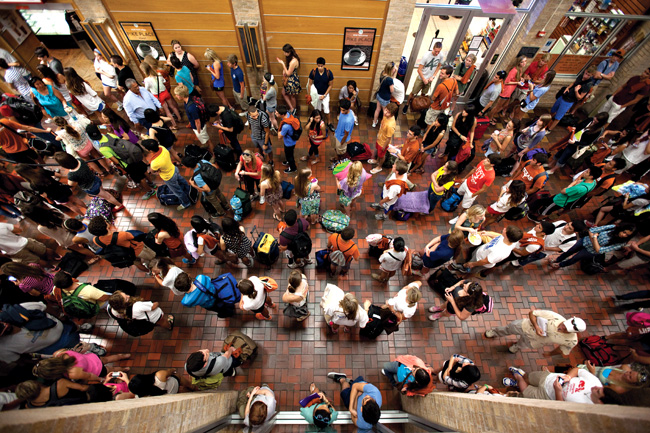Administrators across the University are prepared for issues that may arise from an increase in student enrollment this year of about 800 to 1,000 students.
The entering class of 2016 is expected to be between 8,000 and 8,500 students. The University expected 46 to 47 percent of students offered admissions to accept for fall 2012, but 51 percent are currently planning to attend.
Kedra Ishop, vice provost and director of admissions, said the admissions office was predicting 7,400 to 7,600 students to accept enrollment. In the last five years, freshmen fall admission numbers were approximately between 7500 and 7900. But historically, from 1998 to 2002, the freshman admission numbers were more than 8000 — the University admitted 8788 in 2000.
“A 4 to 5 percent increase this year was a tremendous jump,” Ishop said.
Ishop said the University admits too many students similar to the way airlines overbook passengers — because it knows a certain number of students will decline. This allows UT to use a small waitlist, unlike other universities that maintain large waitlists that are almost the size of an incoming class, Ishop said.
Ishop said there were changes in efforts during student recruitment to increase the yield rate and enroll more top prospects. Ishop said while this means the school admits a strong class, it also means historical trends are less reliable in predicting yield rates.
“We will adjust our offer rate to accommodate this phenomenon, as well as to accommodate the increased efforts on the part of the University to collectively engage in the recruitment of the class,” Ishop said. “In doing so, as the math would indicate, we’ll offer fewer [admissions].”
With this increase in enrollment, the School of Undergraduate Studies is expecting a 66 percent increase in students and the “undeclared” major may become the largest major on campus, according to David Spight, assistant dean for advising in the School of Undergraduate Studies.
Because of this, David Laude, the newly appointed senior vice provost of Enrollment and Graduation Management, said a lot of the focus for the incoming class will be assisting the school.
“That means making sure there is more advising in place, making sure there is more first year freshman programs for them, and we are already working on that,” Laude said.
Some of these measures are being handled at orientation, where students will spend four hours learning about their colleges instead of the two-and-a-half hours that was in place last year. But for the school year, Spight said the School of Undergraduate Studies increased its number of First-year Interest Groups from 15 to 23 to help handle the greater number of students. The school is also trying to add a Transfer Interest Group to provide similar services to transfer students.
Despite UGS receiving a bulk of the increase, Spight said this was something that is going to positively affect schools and colleges.
“This has created another great opportunity for the colleges and schools to work more collaboratively with each other for the benefit of all UT students,” Spight said. “Some of the best solutions come from the most challenging times.”
New Student Services, the division that runs orientation programs, is also dealing with the increase in student enrollment. The campus is currently hosting about 1,200 freshmen at its first orientation session. Kyle Clark, assistant director of New Student Services, said while the University has handled large orientations before, each orientation will be at maximum capacity.
“So far, this has not presented any challenges for us that were unforeseen,” Clark said.
While UGS and NSS have taken measures to deal with the incoming class, the Division of Housing and Food Services and UT’s Federal Work-Study program are not anticipating the class size to cause problems.
Laurie Mackey, director of DHFS, said housing has more requests than room availability every year, but they are always able to fill every housing request by the end of summer. UT does not require incoming freshmen to live on campus, something several Universities across the country mandate.
“Each time a student decides not to live on campus or not to attend UT, we are able to give [his or her] space to another student,” Mackey said. “We offer housing contracts weekly and right now incoming freshman are our first priority.”
Mackey also said the increase will not be a problem for dining centers.
“Due to the fact that we always open completely full and we are not increasing the number of beds, there will not be an overflow of residents in the dining centers,” Mackey said. “Should students who do not live on campus decide to eat in our dining centers, we may see additional traffic but nothing we cannot handle.”
And Linda Morgan, student employment supervisor for the work-study program, said students will still be able to find jobs on campus, through work-study or otherwise. Morgan said work-study is stressing this to students at orientation. Last semester, there were 7,000 undergraduate students who worked on campus and only 1,000 of them were hired through work-study.
“If students want to work then by golly, they’re going to work,” Morgan said.





















